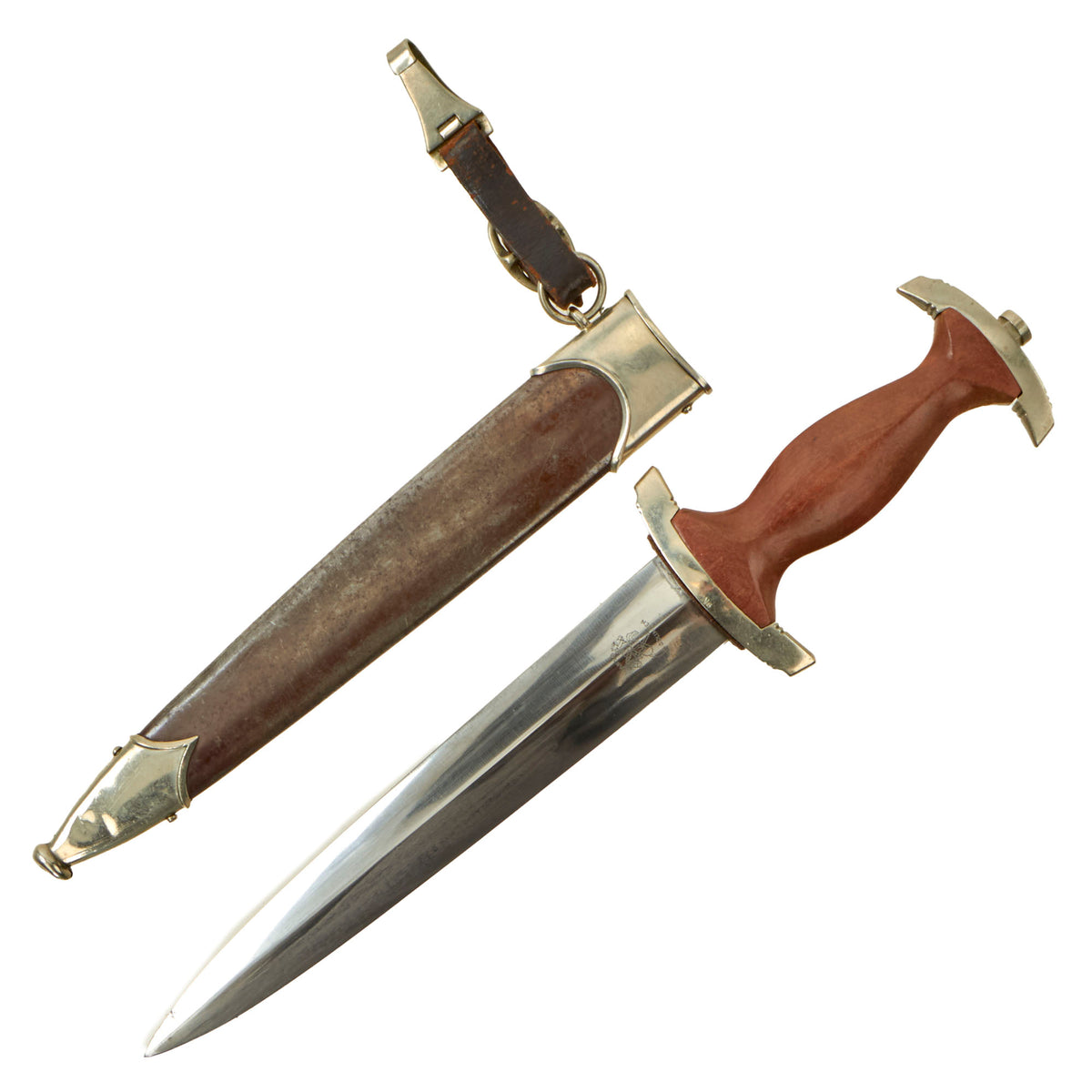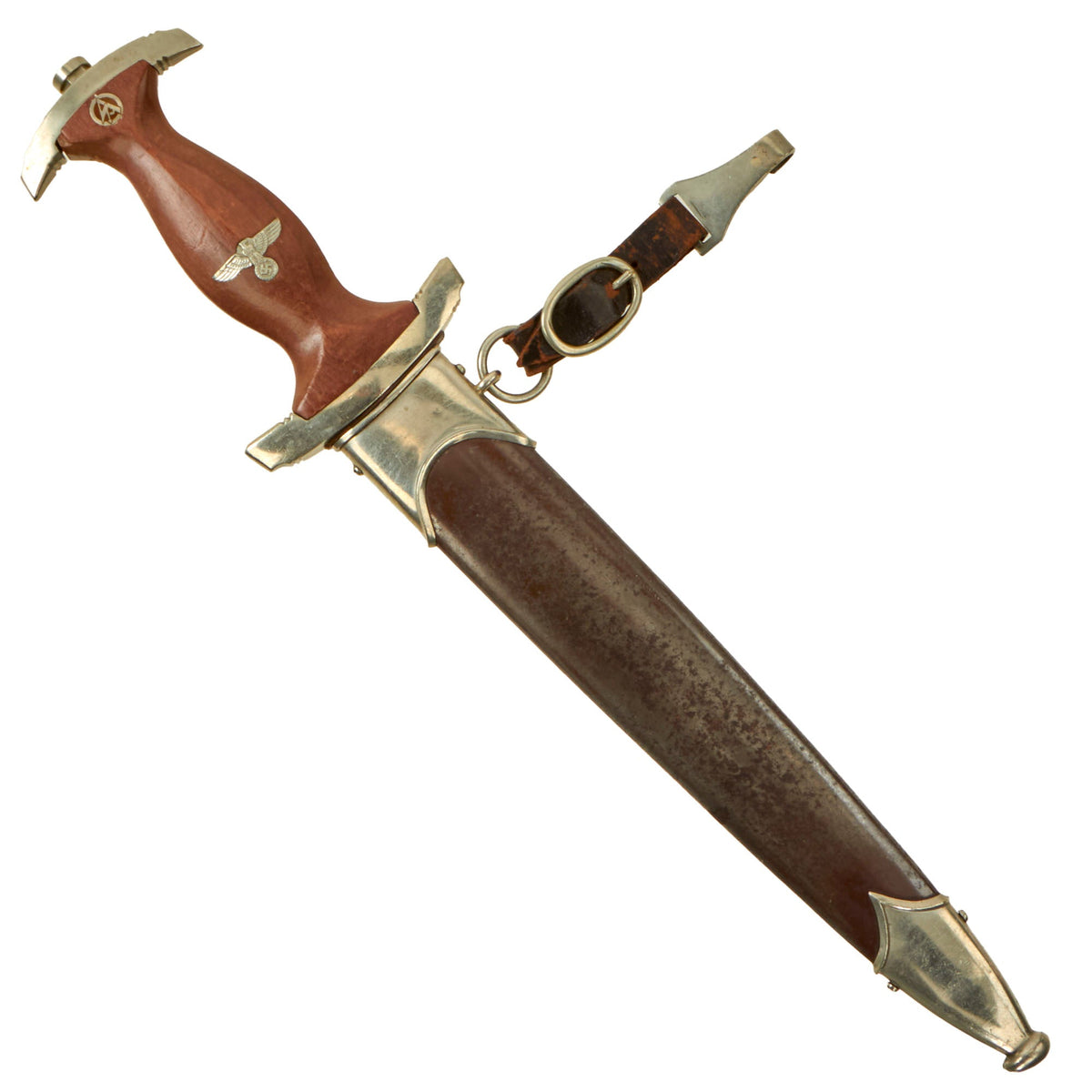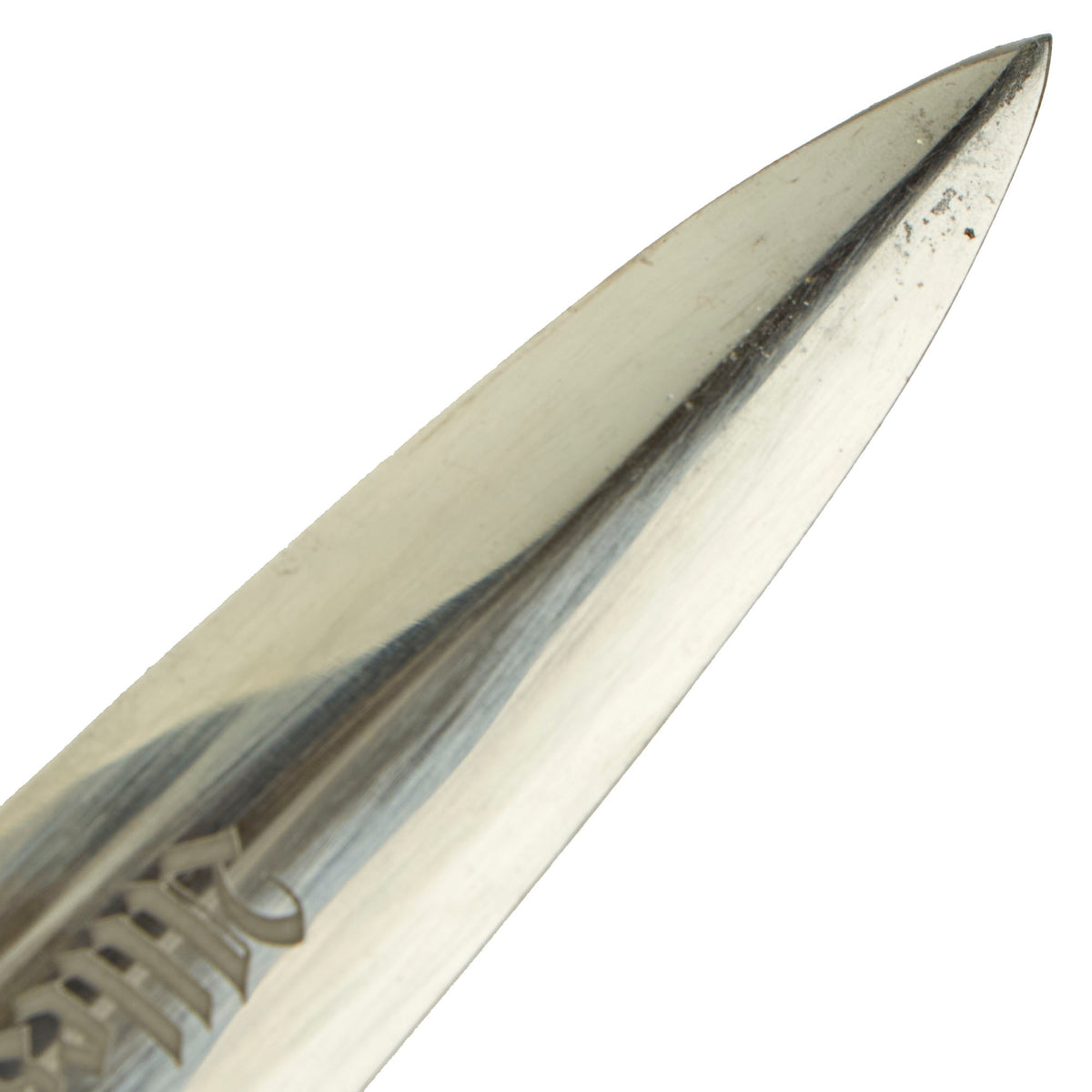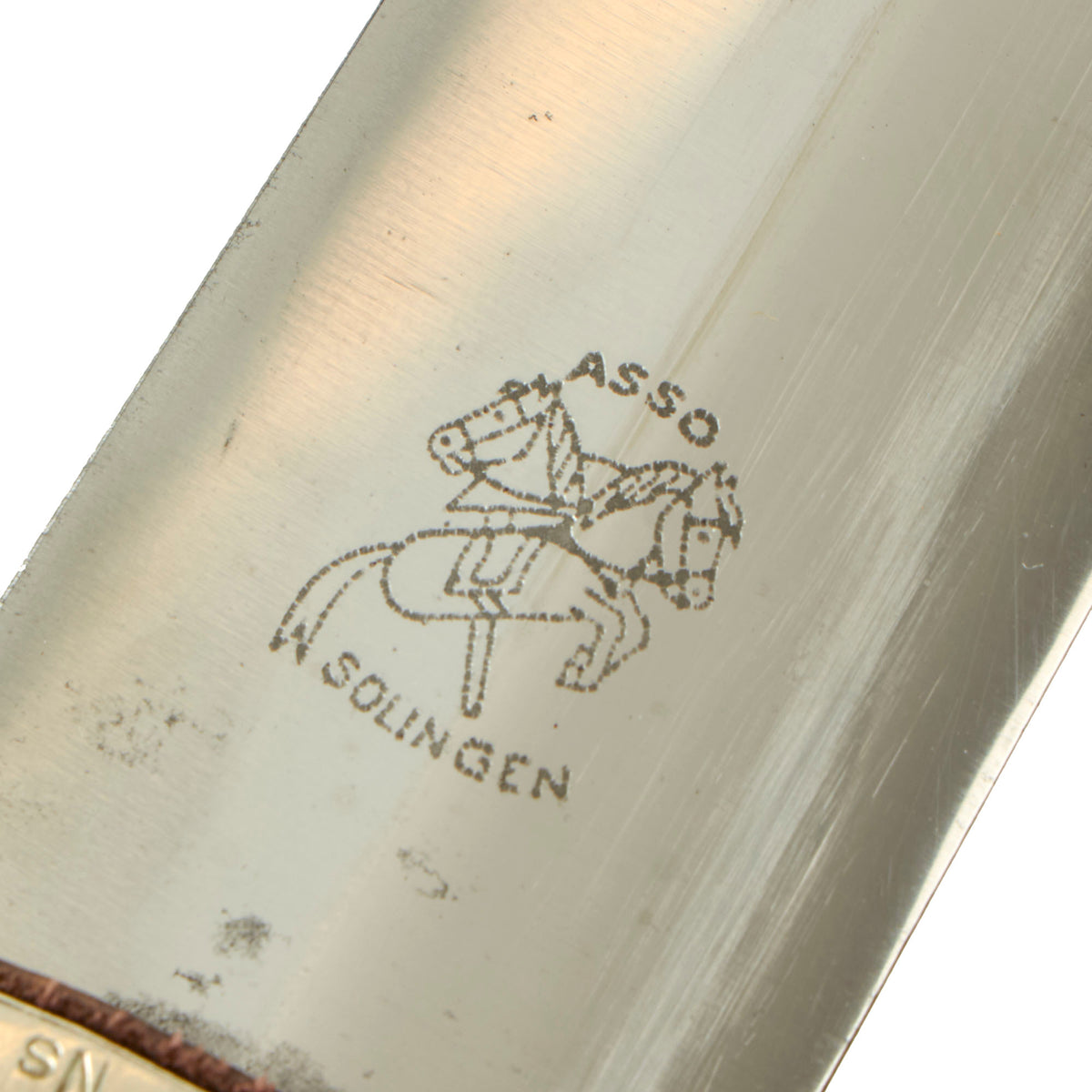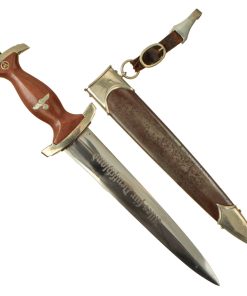Original German Early WWII SA Dagger by Rare Maker ASSO Artur Schüttelhöfer & Co. with Scabbard and Hanger Original Items
$ 1.195,00 $ 298,75
Original Item: Only One Available. This is an excellent condition early pattern SA Dagger, made by the rare maker Artur Schüttelhöfer & Co., Stahlwarenfabrik (Steelware factory) of Solingen, the legendary “City of Blades” in Western Germany. This is a very rare maker, and we have only had a few items by them that were not RZM marked. It comes complete with an original scabbard, which is the correct early war anodized pattern, with an attached early war pattern hanger.
The dagger has solid nickel silver fittings throughout, and is a great example with a lovely look. The crossguards and tang nut are in very good condition throughout with all fittings having a nice lightly aged patina. There is just a bit of age to these mounts but there is no lifting anywhere, showing that they are solid and not plated. They show only light wear with just a bit of light denting and scratching, and do look to have been cleaned a bit over the years, however the accent grooves are still strong. The lower reverse guard is Gruppe/Gau marked Ns, for Niedersachsen (Lower Saxony) a district in north central Germany, with the principal city being Hannover. This feature was only seen on daggers produced 1935 and prior.
The grip is a fine product having a lovely mahogany color, with medium center ridge construction, showing only light wear with a few small pressure dents. The wood is still in very good condition, with some great color variation, and fits the cross guards nicely. There aside from a small chip by the pommel guard, there is no cracking or other missing wood. The pommel nut shows just a bit of turning on the hexagonal area, and the grip is still tightly secured, with no wiggle. The SA symbol button is nicely set, with the translucent enamel is fully intact, and the plating fully retained. The grip eagle is a fine example being the style with beak that points straight. It has just a bit of verdigris on it, showing that it is solid nickel alloy, and it has patinated nicely. The details are still there to the eagle to include the beak, breast feathering, wing feathering, talons, wreath and mobile swas (hook cross).
The blade is in excellent condition and bright, still showing almost all of the original factory final grind cross grain on both sides! This texture is iconic, and is the definitive identifying characteristic for a real WWII German Blade. It shows very little in terms of heavy cleaning, and the cross grain is present throughout, with the usual wear from the scabbard runners. There are just a few small areas of oxidation from runner contact, and the edge is correctly unsharpened, with a fully intact tip. The acid-etched Alles für Deutschland (Everything for Germany) SA motto is crisp, and the factory darkening retained at about 50%.
The reverse of the blade is clearly marked with the “Two Hobby Horses in Saltire” trademark of Artur Schüttelhöfer & Co., surrounded by their trade name and location:
ASSO
(Trademark)
SOLINGEN
Artur Schüttelhöfer & Co. Stahlwarenfabrik (Steelware factory) was based in the Wald neighborhood of Solingen, the legendary “City of Blades” in Western Germany. This company was founded in 1920, and assembled and finished daggers for political organizations and officers during the Third Reich period, per J. Anthony Carter’s excellent book GERMAN KNIFE AND SWORD MAKERS. They manufactured SA, NSKK, and SS daggers, among other items. Most that we have seen have been later RZM marked examples, making this the first early pattern example that we have seen, and it’s a great one!
The scabbard shell is straight and dent free, unlike most that we see. It is the correct early-war style, with a brown “anodized” finish on the steel, which was then lacquered. This example has lost much of the lacquer, which has allowed the anodized finish to wear, and some oxidation to occur to the steel shell. The original finish is only well retained near the fittings, which is a fairly standard wear pattern, and has a great aged look. The upper and lower fittings are solid nickel silver, with a great lightly used look. The chape fitting at the end of the scabbard is dented in and split, as the nickel alloy is somewhat soft, a common thing to see. The throat nicely matches the crossguards, and all fittings have their original dome headed screws, which are in very good shape.
Attached to the hanger ring on the scabbard is a very nice early pattern belt hanger, with solid nickel hardware and dark brown or black finished leather. The leather is in good condition, showing a wear and cracking to the finish, but no tearing or other major damage. There is no maker marking we can see on the fully functional end clip.
An excellent early war SA dagger from a very rare and desirable Solingen maker, complete with an original scabbard and hanger. Ready to display!
Specifications:
Blade Length: 8 3/4″
Overall length: 13 3/4”
Crossguard: 3”
Scabbard Length: 10”
History of the SA-
The SA or Brown Shirts, were a private political formation which Adolf AH and the NSDAP used to maintain order at organized Party meetings and demonstrations. The group was formed in 1921, and grew to a huge force of nearly 3,000,000 men by the later 1930’s. To instill esprit de corps, as well as create employment for the Blade City of Solingen, it was decided each SA man would carry a dagger with his Brown Shirt uniform. Huge quantities needed to be produced to accommodate the demand. The dagger initially was produced of hand-fitted nickel mounts with attractive finished wood grip and brown anodized (a bluing process) finished scabbard.
The blade was etched with the SA motto, Alles für Deutschland. Examples produced prior to 1935 were stamped with the German sector of the SA group on reverse lower crossguard. Later examples underwent standardization through the RZM ministry. These pieces were produced of cheaper plated zinc-base fittings and scabbards were simply painted brown.
Prior to his “unmasking” as a traitor, Ernst Röhm was the leader of the SA. In 1934, he distributed approximately 100,000 SA daggers with his personal inscription on the reverse blade. These daggers were to honor individuals who had served with the SA prior to December, 1931. Other than the inscription, these pieces were identical to the standard M1933 SA dagger. After the Röhm purge, the inscription was ordered to be removed. Many examples were returned to the factory for grinding. Others were simply ground in the field by whatever means were available. Examples will occasionally be encountered with remnants of the original inscription remaining on the blade, but mostly none will remain. Some blades exist with an intact inscription, reflecting only the removal of the Röhm signature. Very very rarely is an example seen with a full, untouched inscription, as the holder would have surely risked a charge of treason.
Fast Shipping with Professional Packaging
Thanks to our longstanding association with UPS FedEx DHL, and other major international carriers, we are able to provide a range of shipping options. Our warehouse staff is expertly trained and will wrap your products according to our exact and precise specifications. Prior to shipping, your goods will be thoroughly examined and securely secured. We ship to thousands clients each day across multiple countries. This shows how we're dedicated to be the largest retailer on the internet. Warehouses and distribution centres can be located throughout Europe as well as the USA.
Note: Orders with more than one item will be assigned a processing date depending on the item.
Before shipping before shipping, we'll conduct a thorough inspection of the items you have ordered. Today, the majority of orders will be delivered within 48 hours. The delivery time will be between 3-7 days.
Returns
The stock is dynamic and we cannot completely manage it because multiple stakeholders are involved, including our factory and warehouse. So the actual stock may alter at any time. It's possible that you may not receive your order once the order has been made.
Our policy is valid for a period of 30 days. If you don't receive the product within 30 days, we are not able to issue a refund or an exchange.
You can only return an item if it is unused and in the same state as the day you received it. You must have the item in its original packaging.
Related products
Uncategorized
Uncategorized
Uncategorized
Uncategorized
Uncategorized
Uncategorized
Uncategorized
Uncategorized
Band of Brothers ORIGINAL GERMAN WWII Le. F.H. 18 10.5cm ARTILLERY PIECE Original Items
Uncategorized
Uncategorized
Australian WWII Owen MK1 Machine Carbine SMG Custom Fabricated Replica with Sling Original Items
Uncategorized
Angolan Rebel 1970s era 60mm Inert Display Mortar from Angolan Civil War Original Items
Uncategorized
Uncategorized
Uncategorized
Uncategorized
Armored Burgonet Helmet & Polearm from Scottish Castle Leith Hall Circa 1700 Original Items
Uncategorized
Uncategorized

